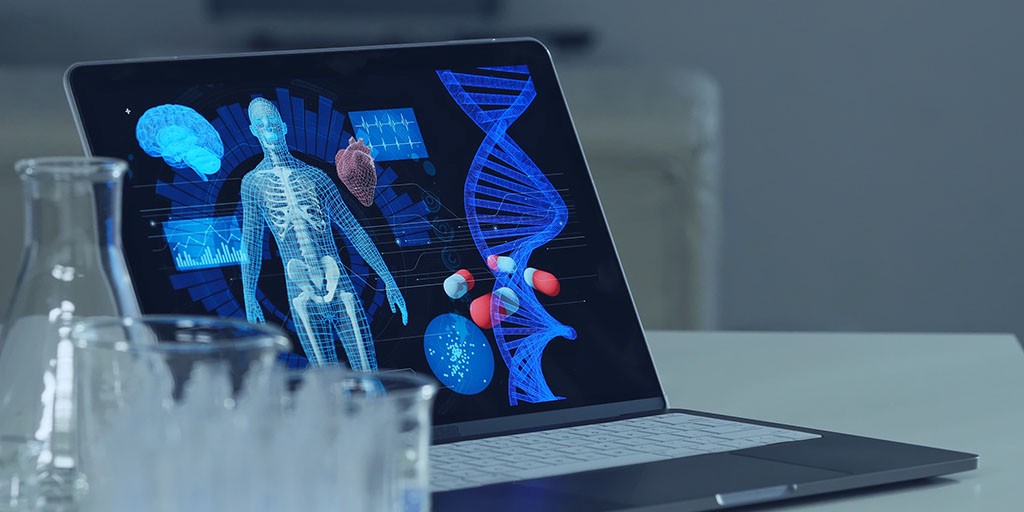Health & Care Transformation (HCT)
research institute, knowledge portal and
advisory consulting
Joaquim Cardoso MSc*
Founder, Chief Researcher & Editor
December 1, 2022
MSc* from London Business School
MIT Sloan Masters Program
Senior Advisor for Health & Care Transformation ,
and Digital Health
Executive Summary [by the Editor]
- Morgan Stanley Research believes that modest improvements in early-stage drug development success rates enabled by the use of artificial intelligence and machine learning …
- … could lead to an additional 50 novel therapies over a 10-year period, which could translate to a more than $50 billion opportunity.
- Predictive diagnostics, enhanced by data, present a significant near-term opportunity for the life sciences industry
- “It’s also likely to resonate with payors, since these trials can generate better outcomes. They can also deliver sizable cost savings by enabling earlier identification and treatment of higher-risk
- But with the high risks involved in creating biologically feasible treatments, and the limited history of the technology platforms involved, investors will need to see solid evidence for real-world use cases for AI-enabled drug discovery.
ORIGINAL PUBLICATION (morgan stanley)

How AI Could Speed Drug Discovery
Biotechs are applying AI and machine learning to drug development, potentially creating dozens of new medicines and a $50 billion market over the next decade.
Here’s what that means for patients and investors.
Morgan Stanley
September 9, 2022
For biotechnology companies, much of the traditional process of discovering new drugs is costly guesswork.
But a new wave of drug development platforms, enabled by artificial intelligence, is helping companies use vast data sets to quickly identify patient response markers and develop viable drug targets more cheaply and efficiently.
But a new wave of drug development platforms, enabled by artificial intelligence, is helping companies use vast data sets to quickly identify patient response markers and develop viable drug targets more cheaply and efficiently.
The results could be transformative not just for medical providers and patients suffering from hard-to-treat diseases, but for the biotech sector:
Morgan Stanley Research believes that modest improvements in early-stage drug development success rates enabled by the use of artificial intelligence and machine learning could lead to an additional 50 novel therapies over a 10-year period, which could translate to a more than $50 billion opportunity.
Morgan Stanley Research believes that modest improvements in early-stage drug development success rates enabled by the use of artificial intelligence and machine learning could lead to an additional 50 novel therapies over a 10-year period, which could translate to a more than $50 billion opportunity.
“Predictive diagnostics, enhanced by data, present a significant near-term opportunity for the life sciences industry,” says Tejas Savant, who covers life science tools and diagnostics at Morgan Stanley Research.
“It’s also likely to resonate with payors, since these trials can generate better outcomes. They can also deliver sizable cost savings by enabling earlier identification and treatment of higher-risk
“It’s also likely to resonate with payors, since these trials can generate better outcomes. They can also deliver sizable cost savings by enabling earlier identification and treatment of higher-risk

The AI Opportunity
Technological advances in recent years have made it easier to capture and store reams of digital patient data.
This has resulted in rich troves of genomic data, health records, medical imaging and other patient information that AI platforms can mine to help to develop drugs faster and with greater chance of success in the early stages of creation.
Technological advances in recent years have made it easier to capture and store reams of digital patient data.
This has resulted in rich troves of genomic data, health records, medical imaging and other patient information that AI platforms can mine to help to develop drugs faster and with greater chance of success in the early stages of creation.
Morgan Stanley Research biotechnology analysts Matthew Harrison and Vikram Purohit estimate that …
… “a 20% to 40% reduction in costs for preclinical development across a subset of U.S. biotech companies could generate the cost savings needed to fund the successful development of four to eight novel molecules.”
This would represent as much as a 15% increase of approved therapies over the total number of novel drug approvals in 2021, demonstrating the potential for biotechs to generate new revenue while helping more patients.
The pairing of AI and big data could help patients in other ways.
In addition to drug discovery and development, advanced data-analysis capabilities and richer data sets could help medical professionals assess patients’ risk and detect disease earlier.
In addition to drug discovery and development, advanced data-analysis capabilities and richer data sets could help medical professionals assess patients’ risk and detect disease earlier.

Creating a Foundation for Valuation
For biotech firms, it can take a blockbuster drug discovery just to break even.
The median investment required to bring a new drug to market is estimated to be nearly $1 billion, while the true cost of research and development may be as high as $2.5 billion per marketed therapy, when factoring in abandoned trials and clinical failures.
The median investment required to bring a new drug to market is estimated to be nearly $1 billion, while the true cost of research and development may be as high as $2.5 billion per marketed therapy, when factoring in abandoned trials and clinical failures.
That means that savings from AI could offer significant value.
But with the high risks involved in creating biologically feasible treatments, and the limited history of the technology platforms involved, investors will need to see solid evidence for real-world use cases for AI-enabled drug discovery.
But with the high risks involved in creating biologically feasible treatments, and the limited history of the technology platforms involved, investors will need to see solid evidence for real-world use cases for AI-enabled drug discovery.
Morgan Stanley Research analysts anticipate an inflection point for the sector, driven by data readouts from drug trials over the next two years.
An increase in collaboration between AI drug developers and large biopharma companies could also make a difference.
Morgan Stanley Research analysts anticipate an inflection point for the sector, driven by data readouts from drug trials over the next two years.
“If initial readouts are consecutively strong, we believe stocks across the space could rise as investors gain confidence in a well-defined total addressable market for AI-enabled drug development,” …
… says Purohit, who covers small and mid-size biotechs.
“In addition to strong data, we expect the market to look for concrete steps forward with biopharma partnerships as proof of validation.”

Along with new data and progress on partnerships, investors will have to weigh how individual firms are using AI and machine learning to develop drugs.
They should also consider the biotech industry’s range of business models, with revenue coming from a mix of proprietary pipeline development and a combination of milestone payments and royalties from programs developed with biopharma partners.
Originally published at https://www.morganstanley.com
Names mentioned
Tejas Savant, who covers life science tools and diagnostics at Morgan Stanley Research.
Morgan Stanley Research biotechnology analysts Matthew Harrison and Vikram Purohit












